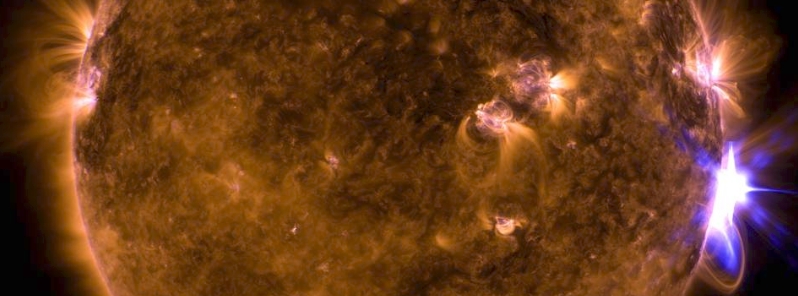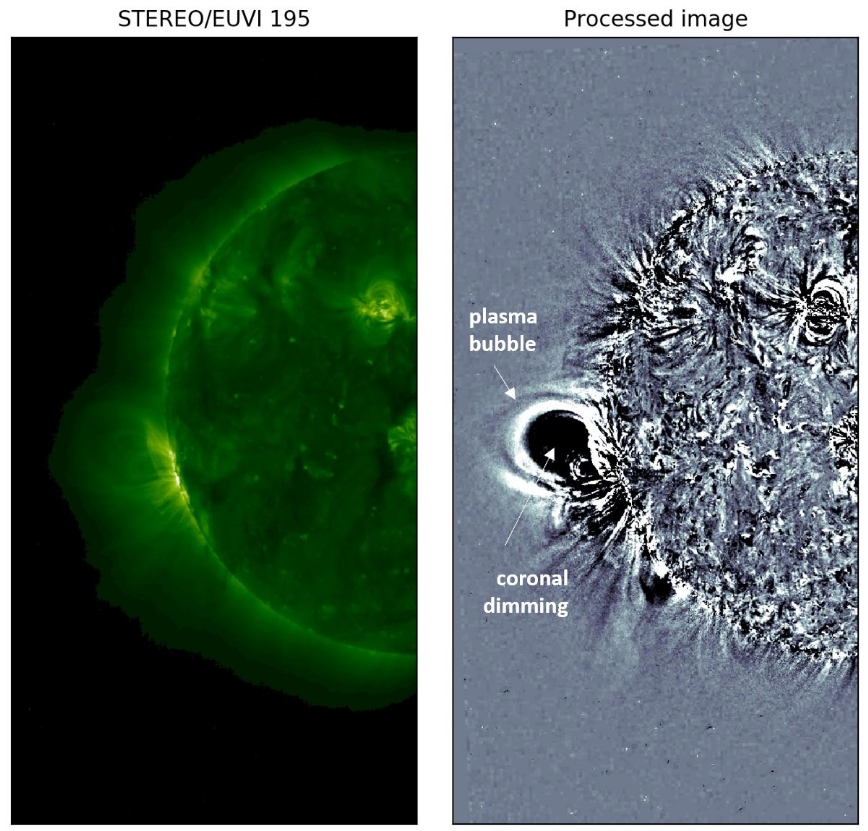Scientists develop new automatic method for detecting traces of Sun’s coronal mass ejections

Scientists at the Skolkovo Institute of Science and Technology in Russia along with colleagues from the Karl-Franzens University of Graz and the Kanzelhoehe Observatory, Austria have formulated a new automatic method for tracking coronal dimmings or traces of coronal mass ejections at the Sun. The researchers also proved that they are credible indicators of the early diagnosis of powerful energy emissions from the Sun's atmosphere, heading to the Earth at great speed.
Coronal mass ejections are one of the most striking displays of solar activity. Massive plasma clouds pierced by magnetic lines are emitted from the Sun's atmosphere into the surrounding space at speeds of 100 to 3 500 km/s (62 to 2 175 mps).
If charged particles reach the Earth, auroras and magnetic storms occur in the atmosphere, which can lead to major problems in the operation of electrical equipment and signal disruption, with spacecraft and astronauts in outer space the most vulnerable to harm.
Coronal mass ejections take place in the atmosphere of the Sun– the solar corona– which is very sparse and does not shine as bright as the disk. Thus, the evolution of these ejections can be monitored only with special tools, such as coronagraphs, generating an artificial solar eclipse, and blocking the bright Sun with a dark disk.
Coronagraphs on Earth do not give precise results due to the sky's bright glow, so they are commonly installed on spacecraft. There are only two coronagraphs in space– one aboard the STEREO-A and another in SOHO satellite. However, coronagraph observations have a drawback– blocking the solar disk by some radii makes it impossible to identify the early evolution of the emission, but only its shape at a developed stage.
A composite view of the coronal mass ejection via STEREO-A instruments: EUVI imager and coronagraph COR2. Image credit: STEREO-A/EUVI + COR2
Researchers said one can approach the solution from another angle and study the trace directly on the Sun, rather than the coronal ejection itself. If one will observe the solar corona in the ultraviolet, gaps in the intensity can be seen– dark spots that are associated with the loss of substance in the corona during the plasma ejection, or the dimmings.
It was for the first time possible to compare the brightness and size of coronal dimming from different observation spots. The results confirm the earlier work of the study's co-authors, where the same dimmings were examined on the solar disk using SDO satellite images.
"We showed that by observing dimmings on the Sun, it is possible to estimate the mass and speed of the coronal mass ejection at early stages – key parameters that allow us to predict the scale of the event and the time of its expected consequences on Earth," said lead author Galina Chikunova.
"This is of great applied importance for the development of operational space weather services, as well as for future space missions to the Lagrange point L5. Spacecraft will be located in the orbit, always retaining the same position with respect to the Earth."
"This will make it possible to detect traces of coronal mass ejections directly on the Sun, as well as to predict the parameters of powerful ejections before they are seen from Earth."


STEREO/EUVI, Coronal dimming, and the associated coronal mass ejection. Image credit: Skolkovo Institute of Science and Technology
Co-author Tatyana Podladchikova also stated, "Humanity is entering a new era in the exploration of outer space, the creation of new space technologies that are gradually moving into our daily lives.
"At present, it is very important to study the nature of explosions on the Sun, to develop methods for their early forecasting, in order to protect our society and technologies from the dangers of space weather, to turn off the equipment in satellites in time, to move astronauts to a protected area, to cancel satellite maneuvers, air travel through the polar regions, report possible navigation problems."
"And whatever storms may rage, we wish everyone good weather in space."
Reference
"Coronal Dimmings Associated with Coronal Mass Ejections on the Solar Limb" – Chikunova, G. et al. – The Astrophysical Journal – DOI: 10.3847/1538-4357/ab9105
Abstract
We present a statistical analysis of 43 coronal dimming events, associated with Earth-directed CMEs that occurred during the period of quasi-quadrature of the SDO and STEREO satellites. We studied coronal dimmings that were observed above the limb by STEREO/EUVI and compared their properties with the mass and speed of the associated CMEs. The unique position of satellites allowed us to compare our findings with the results from Dissauer et al. (2018b, 2019), who studied the same events observed against the solar disk by SDO/AIA. Such statistics is done for the first time and confirms the relation of coronal dimmings and CME parameters for the off-limb viewpoint. The observations of dimming regions from different lines-of-sight reveal a similar decrease in the total EUV intensity (c=0.60±0.14). We find that the (projected) dimming areas are typically larger for off-limb observations (mean value of 1.24±1.23×1011 km2 against 3.51±0.71×1010 km2 for on-disk), with a correlation of c=0.63±0.10. This systematic difference can be explained by the (weaker) contributions to the dimming regions higher up in the corona, that cannot be detected in the on-disk observations. The off-limb dimming areas and brightnesses show very strong correlations with the CME mass (c=0.82±0.06 and c=0.75±0.08), whereas the dimming area and brightness change rate correlate with the CME speed (c∼0.6). Our findings suggest that coronal dimmings have the potential to provide early estimates of mass and speed of Earth-directed CMEs, relevant for space weather forecasts, for satellite locations both at L1 and L5.
Featured image credit: NASA, SDO

Commenting rules and guidelines
We value the thoughts and opinions of our readers and welcome healthy discussions on our website. In order to maintain a respectful and positive community, we ask that all commenters follow these rules.